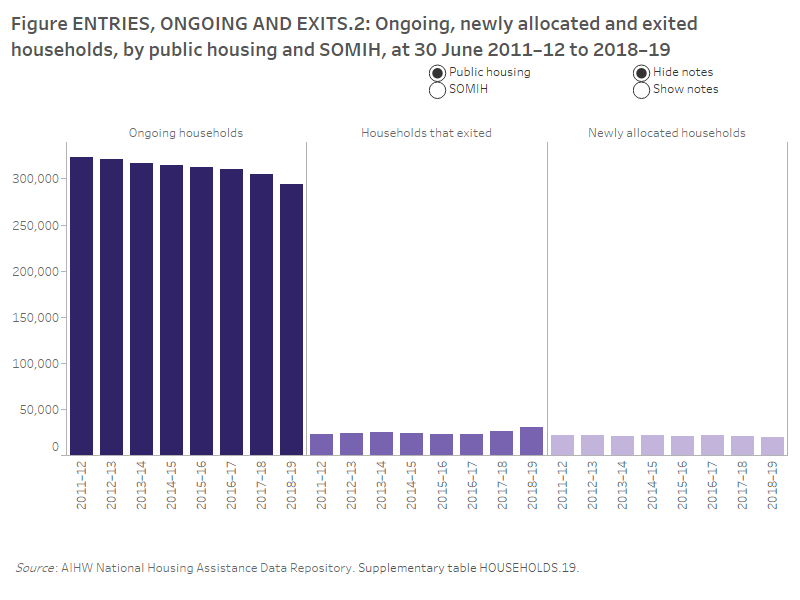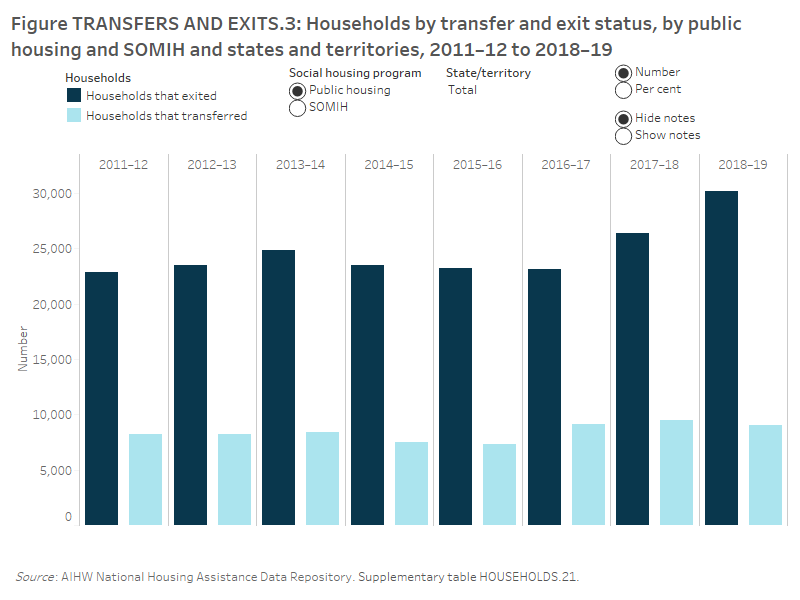Entries, exits and transfers
On this page
Quick facts
- During 2018–19, 42,300 households were newly allocated to public housing, community housing and SOMIH housing dwellings.
- There was a 15% increase in the number of households that exited public housing between 2017–18 and 2018–19, from 26,400 to 30,200.
- During 2018–19, 3% of public housing households and 2% of SOMIH households transferred—or were relocated—to a different dwelling within the same housing program.
Over time, people may be allocated social housing, exit a social housing program, or move from one social housing dwelling to another within the same program (Figure 1). This section presents key data about these entries, exits and transfers. Further detailed analysis of newly allocated social housing for priority groups (special needs and greatest need) and time spent on the waiting list are presented in subsequent sections.
Data on newly allocated households for Indigenous community housing were not available.
Figure 1: Entries, exits and ongoing households

Households entering social housing
Entry into social housing is dependent upon eligibility, with priority needs having an influence on the pathway of people into social housing. Generally, as dwellings become available they are offered to priority applicants, then other waiting list applicants whose eligibility and location requirements match the dwelling (Powell et al. 2019).
In 2018–19, there were 42,300 newly allocated households across public housing, community housing and SOMIH programs. Around half of these were new allocations to community housing (21,300 households), with 19,700 allocated to public housing and 1,400 to SOMIH (Supplementary table HOUSEHOLDS.10).
The number of new entries to public housing has remained relatively stable since 2011–12, at around 20,000 to 21,000 newly allocated households each year (Figure 2; Supplementary table HOUSEHOLDS.19).
Figure ENTRIES, ONGOING AND EXITS.2: Ongoing, newly allocated and exited households, by public housing and SOMIH, at 2011–12 to 2018–19. This vertical bar graph shows that ongoing households make up the highest number of households for both public housing and SOMIH. The number of ongoing public housing households decreased from 323,400 in 2011–12 to 294,100 in 2018–19. The trend for SOMIH differed where the number of ongoing households remained stable from 2011–12 (9,700) to 2017–18 (9,200) but increased in 2018–19 (13,900). In 2018–19, the highest number of public housing households were ongoing at around 294,100, compared with 30,200 households that exited and 19,700 households that were newly allocated. Similarly for SOMIH the highest number of households were ongoing (13,900), compared with 1,300 households that exited and 1,400 that were newly allocated, in 2018–19.

For SOMIH, the 1,400 newly allocated households in 2018–19 was an increase from 1,300 in 2017–18 (Supplementary table HOUSEHOLDS.9). These newly allocated households represented 10% of all ongoing SOMIH households (13,900) at 30 June 2019; up from 9% in 2018 (Supplementary tables HOUSEHOLDS.1).
For community housing, the number of newly allocated community housing households has been increasing over time, from 12,400 in 2013–14 to 21,300 in 2018–19 (Supplementary tables HOUSEHOLDS.9). This increase is in part due to the transfer of dwellings from public housing to community housing in NSW in 2018–19 and South Australia in 2017–18.
Characteristics of newly allocated households
For public housing, newly allocated households were mostly single adults (53%) and sole parents with dependent children (28%). Other key features of newly allocated households in public housing for 2018–19 include:
- for 3 in 5 households, the main tenant was female (59% female and 39% male)
- 3 in 10 households were Indigenous (26%)
- 2 in 5 households had a member with disability which is similar to the per cent in ongoing households (32% for newly allocated compared with 40% for ongoing households) (Supplementary tables HOUSEHOLDS.4 and HOUSEHOLDS.8).
For SOMIH, newly allocated households were most commonly group and mixed composition households (37%) and sole parents with dependent children (34%). In contrast to the other programs, newly allocated households in SOMIH were less likely to be single adults (13%). Around 7 in 10 households had a female main tenant (69%) (Supplementary table HOUSEHOLDS.8).
Data on newly allocated households for community housing and Indigenous community housing were not available.
Characteristics of dwellings
In 2018–19, newly allocated households in the public housing program were more likely to be allocated dwellings with fewer bedrooms (36% 1 bedroom, 31% 2 bedrooms, 28% 3 bedrooms and 5% 4 or more bedrooms), consistent with the household characteristics. For SOMIH, over half of newly allocated households were for 3 bedroom dwellings (56%), with a further 22% in 2 bedroom and 16% in 4 bedroom dwellings (Supplementary table HOUSEHOLDS.12).
A higher proportion of newly allocated public housing and SOMIH households were in smaller dwellings compared with existing dwelling stock (Supplementary table HOUSEHOLDS.12 and DWELLINGS.8).
- For public housing, 36% of newly allocated households were in 1 bedroom or bedsit, compared with 25% of existing dwellings.
- For SOMIH, 22% of newly allocated households were 2 bedroom dwellings, compared with 18% of existing dwellings.
Newly allocated households were also less likely to be in separate houses (HOUSEHOLDS.11 and DWELLINGS.7).
- For public housing, 27% of newly allocated households were in separate houses compared with 38% of existing dwellings. A further 45% of newly allocated households were in flats, units or apartments compared with 35% of existing dwellings.
- For SOMIH, 77% of newly allocated households were in separate houses compared with 83% of existing dwellings.
Households exiting social housing
Households may exit social housing for a number of reasons, for example, the occupant secured private accommodation, eviction or the occupant was no longer eligible for social housing based on their income.
Between 2011–12 and 2018–19, the number of households that exited public housing programs has varied. From year to year, the change in the number of households that have exited ranged from 22,900 in 2011–12 to 30,200 in 2018–19. The proportion of households that exited, increased from 7% in 2011–12 to 9% in 2018–19 (Supplementary table HOUSEHOLDS.21).
In recent years, there have been more households that exited public housing compared with newly allocated households into public housing. In 2018–19, 30,200 households exited while 19,700 households were newly allocated to public housing (Supplementary table HOUSEHOLDS.19). This is in part due to stock transfers from public housing to community housing.
In 2018–19, more households exited SOMIH compared with the previous year (1,300 compared with 1,000 in 2017–18). In 2018–19, the number of households exiting SOMIH was similar to the number of newly allocated households (1,400) (Supplementary table HOUSEHOLDS.19).
Households transferring dwellings
Occupants may transfer between dwellings within the same social housing program if circumstances change, for example, change to household composition resulting in overcrowding, occupants experience family violence and need to move or through stock renewal and re-development. Transfers may be initiated by the tenant or the housing provider and can include mutual exchanges of properties between eligible tenants.
During 2018–19, 3% of public housing households and 2% of SOMIH households transferred—or were relocated—to a different dwelling within the same housing program (Supplementary table HOUSEHOLDS.21).
Key details about households that transferred dwellings within public housing include:
- for 2 in 3 households, the main tenant was female (67% female and 31% male)
- almost half of households had a main tenant aged over 50 years (48%)
- 42% of households had a member with disability, while 46% did not (12% not stated) (Supplementary table HOUSEHOLDS.20).
The Northern Territory had a comparatively higher proportion of households that transferred within public housing (6%, or 300 households) while NSW had a lower proportion (2%, or 2,400 households) (Figure TRANSFERS AND EXITS.3; Supplementary table HOUSEHOLDS.21).
Figure TRANSFERS AND EXITS.3: Households by transfer and exit status, by public housing and SOMIH and states and territories, 2011–12 to 2018–19. This vertical bar graph shows nationally the number of public housing and SOMIH households that exited were higher than those that transferred, from 2011–12 to 2018–19. In 2011–12, 22,900 public housing households exited and 8,200 households transferred; in 2018–19, 30,200 households exited and 9,000 transferred. In 2011–12, around 650 SOMIH households exited and 300 transferred; in 2018–19, 1,300 households exited and around 300 transferred.

Powell A, Meltzer A, Martin C, Stone W, Liu E, Flanagan K, Muir K and Tually S 2019. The construction of social housing pathways across Australia. AHURI Final Report 316. Melbourne: Australian Housing and Urban Research Institute Limited.


